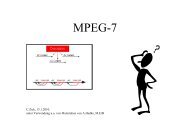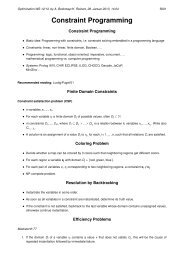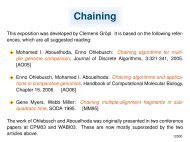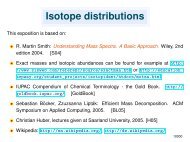Telematics Chapter 6: Network Layer - Freie Universität Berlin
Telematics Chapter 6: Network Layer - Freie Universität Berlin
Telematics Chapter 6: Network Layer - Freie Universität Berlin
You also want an ePaper? Increase the reach of your titles
YUMPU automatically turns print PDFs into web optimized ePapers that Google loves.
Routing Information Protocol (RIP)<br />
● Routing Information Protocol (RIP,<br />
RFC 1058)<br />
● Early internal gateway routing<br />
protocol used in the Internet<br />
● Based on the Distance Vector Protocol<br />
● RIP messages are sent every 30<br />
seconds as UDP datagrams<br />
● Used metric for the evaluation of the<br />
paths is the number of hops<br />
● The maximum number of hops is<br />
limited to 15 � 16 = ∞<br />
● In a message (only) up to 25 entries<br />
of the routing table can be sent<br />
● Fits good for small systems<br />
● Problems:<br />
● Slow convergence (duration of<br />
minutes)<br />
● Count to Infinity<br />
● No considering of subnets<br />
Univ.-Prof. Dr.-Ing. Jochen H. Schiller ▪ cst.mi.fu-berlin.de ▪ <strong>Telematics</strong> ▪ <strong>Chapter</strong> 6: <strong>Network</strong> <strong>Layer</strong><br />
● RIPv2 (RFC 2453):<br />
● Subnets, CIDR<br />
● Authentication<br />
● Multicast, etc.<br />
● However: max. number of hops is still<br />
limited to 15<br />
● RIPng (RFC 2080)<br />
● IPv6 support<br />
● Internet Gateway Routing Protocol<br />
(IGRP)<br />
● As reaction to the restrictions of RIP<br />
Cisco introduced IGRP<br />
● Extension of the metric, load sharing,<br />
more efficient packet format<br />
● The protocols did not become<br />
generally accepted, because they<br />
were Cisco specific<br />
● Replaced by EIGRP (new design)<br />
● Replacement by a Link State<br />
Protocol (OSPF)<br />
6.188
















